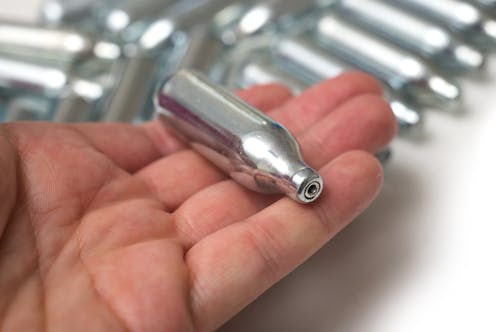Source: The Conversation (Au and NZ) – By Stephen Bright, Senior Lecturer of Addiction, Edith Cowan University

Australia’s Therapeutic Goods Administration (TGA) has been considering whether whipping cream canisters containing nitrous oxide should be placed in Schedule 10 of the Poisons Standard.
Schedule 10 is the most restrictive category within the Poisons Standard, reserved for “substances of such danger to health as to warrant prohibition of sale, supply and use”.
The canisters contain nitrous oxide, which, when mixed with cream in a whipping cream dispenser, creates high-quality whipped cream. This method is used by bakers and chefs worldwide.
There’s no evidence whipping cream canisters pose any risk to people who use them for their intended purpose.
So why has an application been made to the TGA to prohibit whipping cream canisters?
While the applicant hasn’t been named, the proposal is based on increasing concern about people using the canisters to get high.
Read more:
Explainer: what is nitrous oxide (or nangs) and how dangerous is it?
Is nitrous oxide harmful?
Nitrous oxide has been used in medicine and dentistry as an analgesic (a drug which relieves pain) and anaesthetic since it was first found to assist with the extraction of a tooth in 1844.
Commonly referred to as “laughing gas”, nitrous oxide continues to be used in clinical environments in Australia as a Schedule 4 Medicine.
However, no drug is risk-free. There are some harms associated with the recreational use of nitrous oxide (sometimes called “nangs”).
For example, there’s evidence regular heavy use of nitrous oxide can lead to a deficiency in vitamin B12 resulting in peripheral neuropathy. Peripheral neuropathy can be caused by a range of toxins and nutritional deficiencies. Symptoms include unexplained pain, burning and numbness.
In unpublished data submitted to the TGA, 6% of almost 1,900 young Australians who reported nitrous oxide use (surveyed in 2018-2019) reported persistent numbness or tingling, consistent with peripheral neuropathy.
A large global study of people who reported nitrous oxide use found persistent numbness/tingling in the hands or feet was rare (3%) and heavily dependent on dose.
There have also been reports of misadventure resulting in death following its use.

Shutterstock
Some numbers
The 2019 National Drug Strategy Household Survey found roughly 1.7% of Australians had used inhalants in the previous 12 months. But this survey doesn’t specify which inhalants are used, so this number is likely to include many different inhalants, not just nitrous oxide.
The National Drug and Alcohol Research Centre has interviewed people who regularly use MDMA and psychostimulants annually for nearly 20 years to understand more about the drug use habits of this group.
Around one-quarter reported nitrous oxide use from 2003 to 2015. But this proportion doubled to 50% by 2018, and has remained at a similar level in 2020 (54%).
It’s important to note people who use nitrous oxide do so infrequently (on average less than once per month).
As use of nitrous oxide has increased among certain groups, we’ve also seen indications of increased rates of harm. For example, in New South Wales, emergency department presentations associated with nitrous nitrous oxide increased from ten cases per year in 2016 to 60 cases in 2018.
A proportional response?
If the TGA was to make whipping cream canisters Schedule 10 under the Poisons Standard, these products would become prohibited in Australia.
Australian bakers and chefs could be forced to use carbon dioxide canisters, which are sold for Soda Stream machines. But use of carbon dioxide canisters has been reported to result in whipped cream that tastes acidic. It also creates large bubbles in the cream due to the different properties of the two chemicals.
We believe it’s unlikely the TGA will classify whipping cream canisters as being of such danger to health that their sale, supply and use becomes prohibited.
However, the TGA could make whipping cream canisters a Schedule 7 Dangerous Poison. This would mean culinary aficionados could be required to obtain a license to access whipping cream canisters from a limited number of suppliers licensed to sell them. We believe this would also be a disproportionate response.
There’s some evidence that when a drug becomes harder to access, people will substitute that drug with a more harmful drug. Making whipping cream canisters Schedule 7 or Schedule 10 could lead young people to use volatile substances more harmful than nitrous oxide instead (for example, spray paint, deodorant or petrol) since these are likely to be more accessible.

Shutterstock
We’ve made submissions to the TGA arguing classifying whipping cream canisters as Schedule 10 in the Poisons Standard would be a disproportionate response to the harms associated with their use as a recreational drug.
Given they’re widely used by Australian bakers and chefs, we suggested the most pragmatic solution would be for the TGA to place the products in Schedule 5 or 6 of the Poisons Standard.
If the TGA was to list these products in Schedule 5, they would be required to contain warnings on the labelling. If they were placed in Schedule 6, similar restrictions to spray paint would apply, where retailers are required to limit access to the products to minors.
Next steps
The TGA is set to announce its interim decision on this proposal any day now.
The evidence indicates a minority of people, predominantly those who use nitrous oxide at very high doses, are at risk of developing serious neurological problems.
We should be raising community awareness of this risk as we carefully consider the consequences of tighter restrictions on the availability of a product which is generally safe, if used as directed.
![]()
Stephen Bright is a Director of the not-for-profit company Psychedelic Science In Medicine & Research (PRISM) and a Director of the not-for-profit organisation Students for Sensible Drug Policy.
Monica Barratt receives (or has recently received) funding from Australian (National Health and Medical Research Council, the Australian Institute of Criminology, the National Centre for Clinical Research into Emerging Drugs) and international (US National Institutes of Health, NZ Marsden Fund) sources. She has conducted commissioned research for the NSW Coroner’s Office, the WA Mental Health Commission and the Victorian Department of Health. In addition to her role at RMIT, Monica is a visiting fellow at the National Drug and Alcohol Research Centre, UNSW Sydney. She is an editor for two peer-reviewed journals, the International Journal of Drug Policy and Drug and Alcohol Review. She also has leadership roles at two not-for-profit harm-reduction organisations: The Loop Australia and Bluelight.org.
– ref. Whipping cream canisters have many uses beyond ‘nangs’. Banning them isn’t necessary – https://theconversation.com/whipping-cream-canisters-have-many-uses-beyond-nangs-banning-them-isnt-necessary-164870






